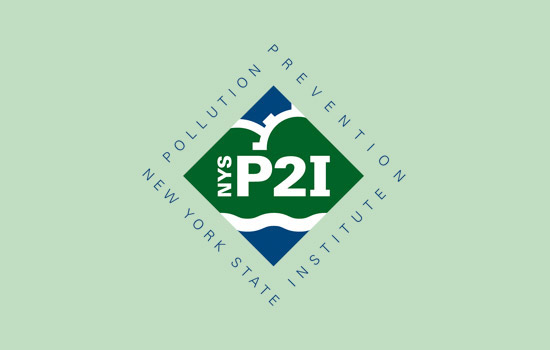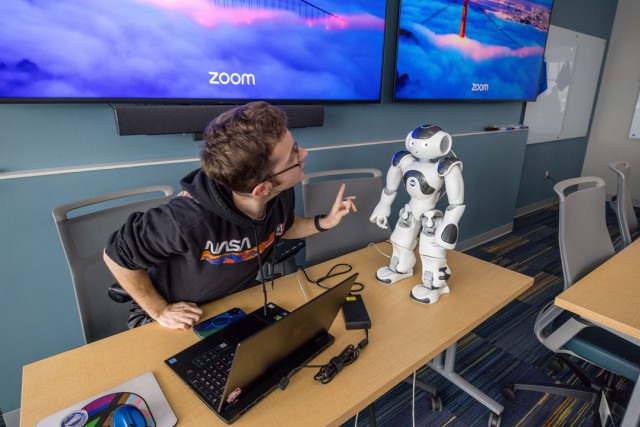RIT to continue to lead Pollution Prevention Institute
NYSP2I has made significant economic, environmental and social impacts statewide since 2008
A Rochester Institute of Technology-led consortium has won a $19.5 million, five-year award from the New York State Department of Environmental Conversation (DEC) to operate the New York State Pollution Prevention Institute (NYSP2I), allowing RIT to continue to lead important environmental projects and initiatives that have a significant impact on businesses and residents statewide.
The contract award for NYSP2I is funded by the state’s Environmental Protection Fund and followed a competitive statewide application process. It is subject to approval from the Office of State Comptroller.
NYSP2I, sponsored by the DEC since its establishment in 2008, is led by RIT’s Golisano Institute for Sustainability. GIS will continue to direct a statewide consortium of environmental experts from leading schools in Binghamton University, Clarkson University, Cornell University and Rensselaer Polytechnic Institute (RPI), whose leaders expressed eagerness to work with RIT to make the state more sustainable for workers, the public, the environment and the economy through pollution prevention.
RIT President David Munson said RIT is “thrilled to receive this award to continue to operate the New York State Pollution Prevention Institute, and we thank Governor Cuomo and DEC Commissioner Basil Seggos for their confidence in RIT.”
“We are proud of the impact that NYSP2I has had in helping businesses reduce their environmental impacts in ways that also improve their operations and their bottom lines,” Munson said. “This partnership with New York state, our terrific university partners and the strong network of statewide Manufacturing Extension Partnerships (MEPs) is a model of successful collaboration that leads to outstanding results, and the re-designation will enable us to engage with more companies and organizations in these efforts.”
Seggos said “NYSP2I’s approach goes beyond compliance-driven activities and focuses on preventing pollution at its source and identifying opportunities to make New York companies more efficient and economically stronger.”
“RIT has done a tremendous job operating NYSP2I for the past decade, and the DEC looks forward to continuing our work together to reduce the pollution entering New York’s environment and the waste entering our landfills,” Seggos added.
Statewide impact
NYSP2I’s accomplishments over the last decade have been far-reaching, including:
- $4.7 million in operational cost savings as a result of direct assistance to state companies.
- More than 300 assistance projects working directly with statewide companies and communities.
- More than 60 companies receiving assistance through its Green Initiative, supporting the potential to create nearly 200 jobs.
- $1.5 million in support of projects through NYSP2I’s Community Grants Program.
- More than $2.5 million to fund 35 Research and Development projects.
- Millions of pounds of reductions in non-hazardous and hazardous materials; air emissions; energy usage in electricity and natural gas; water usage; and wastewater discharge.
Charles Ruffing, director of NYSP2I, noted that the institute has gained a strong reputation for bringing innovative processes and technologies to a wide variety of industry sectors.
“The New York State Pollution Prevention Institute’s accomplishments over the last decade here at RIT, working closely with the DEC and our partners across all corners of the state, have helped provide significant value to a wide range of New York state industries—both environmentally and economically,” Ruffing said. “We look forward to expanding our impact in the future as we work to identify opportunities that will continue to help businesses, communities and the citizens of New York become more sustainable.”
In addition to its partner universities, NYSP2I’s statewide reach is supported by the Empire State Development’s New York State Manufacturing Extension Partnership (MEP), a network that includes FuzeHub and the Center for Economic Growth in Albany, N.Y.; Insyte Consulting in Buffalo, N.Y.; NextCorps in Rochester, N.Y.; Industrial & Technology Assistance Corporation in New York City; Central New York Technology Development Organization in Liverpool, N.Y.; Alliance for Manufacturing & Technology in Binghamton, N.Y.; Center for International Trade, Technology, Education and Communication in Potsdam, N.Y.; Advanced Institute for Manufacturing at Mohawk Valley Community College in Utica, N.Y; Hudson Valley Technology Development Center in Newburgh, N.Y.; and Manufacturing and Technology Resource Consortium at Stony Brook University in Bethpage, N.Y.
Ruffing noted that the DEC’s contract renewal for RIT will enable NYSP2I to continue its fervent focus on assisting companies and industries develop new technologies and practices that both prevent pollution and improve efficiency and productivity.
Second win for RIT
In 2007, the DEC received and evaluated proposals from various universities across the state to host the institute. After an extensive peer review process, a technical committee selected RIT, noting that its proposal was bolstered by solid agreements with other New York universities as well as regional technology development centers to build a research-sharing network.
An additional component of RIT’s proposal included the creation of research and technology test beds—or technological laboratories—across the state through partnerships with universities and the MEP to help disseminate data, tools and strategy.
Pollution prevention is reducing or eliminating waste at the source by modifying production processes, promoting the use of non-toxic or less-toxic substances, implementing conservation techniques and reusing materials rather than putting them into the waste stream.
RIT’s university partners in NYSP2I represent a “dream team” of environmental experts ready to bring their expertise to continue improving the health and environmental quality of New York state.
“The Pollution Prevention Institute creates opportunities for Binghamton University experts to contribute to projects that will have a significant impact on society and on the lives of New Yorkers,” said Bahgat Sammakia, vice president for research at Binghamton University, who added that the collaboration marks an exciting one for researchers there. “We’re eager to bring our experience with industry partnerships and research in smart energy and sustainable communities to this consortium.”
“Collaboration is key to solving the most serious environmental challenges here in New York,” said Kathryn J. Boor, the Ronald P. Lynch Dean of the College of Agriculture and Life Sciences at Cornell University. “We look forward to working together to reduce pollution in ways that both improve community health and establish New York businesses as leaders in environmental protection.”
“It’s been a great partnership to support the New York State Pollution Prevention Institute at RIT for the past 10 years,” said Gina Lee-Glauser, vice president of research at Clarkson University. “Clarkson University continues to look forward to further cooperation for the advancement of New York, both environmentally and economically.”
“On behalf of the Rensselaer Polytechnic Institute, I want to thank the State of New York and the Department of Environmental Conservation for re-designating the team led by the Rochester Institute of Technology to serve as the New York State Pollution Prevention Institute,” said Robert Hull, Henry Burlage Jr. Professor of Engineering, director of the Center for Materials, Devices and Integrated Systems and senior associate vice president for research at RPI. “Rensselaer has a long history of addressing global challenges, conducting energy-related research, and collaborating with industry on advanced processes and manufacturing techniques to reduce environmental impact and enhance efficiency. We look forward to working with our academic and industry partners to ensure that NYSP2I remains an impactful and valuable asset for sustainability efforts throughout the state of New York.”





